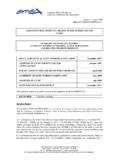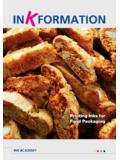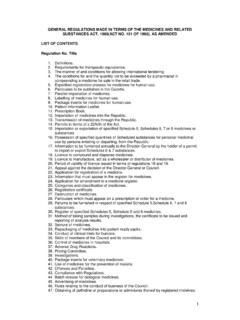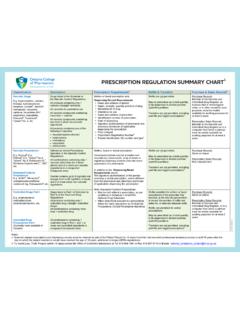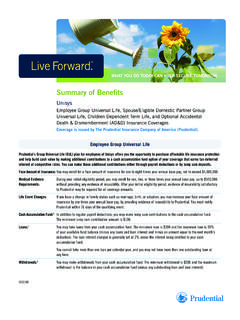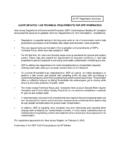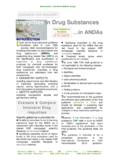Transcription of Pollution Incident Prevention Plan (PIPP) and Part 5 …
1 Pollution Incident Prevention Plan PIPP (PIPP) and Part 5 Rules . Informational Packet ffective August 31, 2001, the Part 5 Spillage of Oil and Polluting Materials I. Summary of revised rules primary E administrative rules promulgated pursuant to Part 31, Water Resources Protection, of the Natural Resources and Environmental Protection Act, 1994 PA 451, as amended (Act 451) MCL et seq. were revised. The II. III. changes Acronyms used in publication What facilities are subject to the previous rules were rescinded and new rules ( through ) Part 5 Rules? promulgated to address release Prevention planning, secondary containment, IV. Answers to commonly asked surveillance, and release reporting requirements. When a rule is referenced in questions this document, it will list Rule and a number that corresponds with the above V.
2 PIPP completeness review citations. For example, Rule 1 is Oversight of these rules was checklist transferred to the Water Division when the Michigan Department of Environmental VI. Additional information to use when Quality (DEQ) was reorganized in 2002. This updated informational packet preparing a PIPP and completing addresses the requirements overseen by the Water Division (WD), clarifications the checklist of interpretations regarding oils managed under federal SPCC regulations and VII. Websites used in publication submittal of notices and certifications, along with discussion about potential relationships with some other regulations. I: SUMMARY OF REVISED RULES PRIMARY CHANGES. 1. The Critical Materials Register is no longer referenced in the Part 5 polluting material definition.
3 Polluting materials are salt, oil, any chemical included in Rule 9, and any compound or product that contains 1% or more, by weight, of these materials [based on the material safety data sheet (MSDS) formulation information]. 2. The new rules clarify the definition of oils and expand the definition of salt. Salt includes sodium chloride, potassium chloride, calcium chloride, magnesium chloride, and solutions or mixtures of these compounds in either solid or liquid form. 3. The new rules identify threshold management quantities (TMQs) for both indoor and outdoor use, storage, and other management areas. Exceeding these TMQs and meeting facility definitions will determine if a PIPP has to be prepared, if containment is required, and if other Part 5 rules must be met. Previous rules did not have minimum volumes identified.
4 4. The new rules include descriptive conditions and threshold reporting quantities (TRQs) for polluting materials which if exceeded, or occur, requires spills or releases to be reported. What is considered as a release under these rules is also clarified. Previous rules did not identify minimum reportable quantities. 5. The new rules include facility exemptions from certain requirements if they meet specified conditions or are subject to other identified regulations. Previous rules did not have exemptions listed. Jennifer M. Granholm, Governor Steven E. Chester, Director June 2003 Pollution Incident Prevention Plan (PIPP) and Part 5 Rules . Informational Packet 6. The new rules require the PIPP to be kept at the facility and available for inspection. Within 30 days of completing the plan, the facility must notify that it is in full compliance with the Part 5 Rules to the WD district office that oversees the area where the facility is located.
5 In addition, the facility must notify the Local Emergency Planning Committee (LEPC). and local health department that the plan has been completed and available upon request. The facility must submit a copy to a requesting agency within 30 days of receiving a request. 7. The new rules require the plans to be evaluated every three years or after any release that requires implementation of the plan. The plan must be updated whenever there are changes to personnel, processes, or procedures identified in the plan. The facility must re-notify the DEQ and locals and recertify compliance when the plans are updated. 8. The new rules clarify the definition of on-land and oil storage facilities and include exemptions for some types of facilities. 9. The new rules provide clarification about secondary containment requirements.
6 Required holding capacity is now consistent with the hazardous waste regulations, , not less of the total volume of the tanks or containers within the secondary containment structure or provide a capacity of 100% of the largest single tank or container within the secondary containment structure, whichever is larger. II: ACRONYMS USED IN PUBLICATION. AWR Annual Wastewater Report MCL Michigan Compiled Laws MIOSHA Michigan Occupation Safety and Health CAA Clean Air Act Act CAS Chemical Abstracts Service Number MSDS Material Safety Data Sheet CERCLA Comprehensive Environmental Response, Compensation and Recovery Act PE Professional Engineer CIS Michigan Department of Consumer and PEAS Pollution Emergency Alerting System Industry Services PIPP Pollution Incident Prevention Plan DEQ Michigan Department of Environmental SPCC Spill Prevention , Control.
7 And Quality Countermeasure EPA US Environmental Protection Agency TMQ Threshold Management Quantity TRI Toxic Chemical Release Inventory ICP Integrated Contingency Plan TRQ Threshold Reportable Quantity HAZWOPER Hazardous Waste Operations and UST Underground storage tank Emergency Response WHMD Waste and Hazardous Materials Division LEPC Local Emergency Planning Committee WD Water Division LQG Large Quantity Generator III: WHAT FACILITIES ARE SUBJECT TO THE PART 5 RULES? Review the administrative rules and ask the following questions when determining if the Part 5 requirements for a PIPP, containment, surveillance, and release reporting apply. 2 June 2003. Pollution Incident Prevention Plan (PIPP) and Part 5 Rules . Informational Packet 1. Does the facility meet the definition of an oil storage or on-land facility per Rule 1(f) or (g)?
8 An oil storage or on-land facility excludes recreational marinas, installations of oil containing electrical equipment, oil storage facilities, oil field petroleum or oil field brine storage facility, and transportation related facilities as defined in 40 CFR Part 112. A. Recreational marinas are places where private pleasure boats are located. A commercial marina includes places where commercial boats and ships (commercial charter and fishing boats, freighters, cruise ships, ferries, etc). are located. B. The electrical equipment must be in active use to be exempted from the Part 5 rules. The volume of oil in electrical equipment in storage (non-energized electrical equipment) must be counted if it does not meet the small container exemptions in Rule 3(1). Examples of equipment include electrical transformers, capacitors, reclosures, voltage regulators, rectifiers, etc.
9 C. Transportation related facilities includes some onshore and offshore facilities and equipment used for handling or transferring oil in bulk from vessels, pipelines, highway vehicles and railroad cars used for interstate and intrastate commerce. Call 312-353-8200 to discuss this transportation related determination with EPA Region V. See the WD operational guidance regarding railroad and truck unloading areas. 2. Does the facility have polluting materials that meet the small container exemption or are regulated by another program listed in Rule 3? When looking at the conditional exemptions under Rule 3, keep in mind that a facility may have some polluting materials exempted, and still have other polluting materials in amounts that are subject to the Part 5 rules. A. Polluting materials in small containers that: 9 do not individually exceed 10 gallons, or 100 pounds, AND.
10 9 are managed indoors, AND. 9 the facility has adequate safeguards to prevent releases. This would apply to retail stores and facilities that use products in small amounts, or in small containers, and meet all of the rule conditions. This exemption would include small lead acid batteries containing sulfuric acid, and smaller capacitors, ballasts, or other items containing small amounts of oils under storage conditions. Batteries used for fork lifts or hi-lows usually do not meet this exemption because they exceed this size and are often used outdoors. B. The conditional exemption in Rule 3(1)(b) is no longer applicable to oils because US EPA revised 40 CFR 112 in 2002 and the Part 5 rules adopt the 1997 Spill Prevention , Control and Countermeasure (SPCC) regulations (40. CFR Part 112) version.










